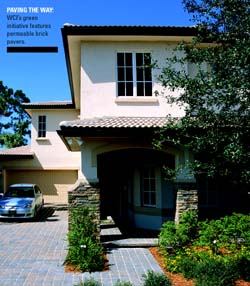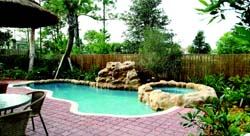What do you do when your CEO mandates that from this day forward your company will be a leader in building and developing sustainable communities? You listen, of course. And you act. But if you are WCI, the big Florida-based builder and developer, you are also smart enough to realize that this kind of thing doesn’t happen overnight. To lead, you must first learn, which is the basis behind WCI’s “Generation Green” concept house at its Evergrene development in Palm Beach Gardens.
With fiber optic recessed lighting that uses one bulb to illuminate an entire room, a compost system that returns up to 30 percent of household waste to the soil, and numerous features made from recycled materials, the house—which opened in August and is called Geni G for short—is said to be the greenest in the state, exceeding what the Florida Green Building Coalition considers green by more than 50 percent.
“Our legacy will ultimately be marked by our ability to maintstream green building and sustainability in the home building industry,” says Hoffman. “For this to happen, we must show customers the features and benefits of green homes and why they are better.”
Eventually, many of the features showcased in the 1,500-square-foot model will be standard in WCI’s production houses—and perhaps those of other builders as well. But “first, you’ve got to figure out how to put all the right pieces together,” says Joel Howard, national resource manager in the company’s home building division.
Company spokesman Kyle Reinson calls them “baby steps.” And Howard agrees. “It’s not as easy as going to [The] Home Depot,” says Howard, one of a team of four environmental managers charged with educating consumers, communities, and most importantly WCI’s employees and subcontractors about green building techniques.
All of this is part of WCI’s unprecedented partnership with Audubon International, a not-for-profit environmental organization (not to be confused with the Audubon Society) working to foster more sustainable human and natural communities through research, education, and technical assistance.
Lab For Learning When Evergrene is completed, Geni G will be sold. For now, though, the garage has been transformed into a teaching and learning laboratory to support WCI’s “Habitats for Learning” initiative that will educate local students on green building and sustainable development concepts.
The company also is working with Florida Gulf Coast University—a school known for its environmental studies—to develop a green building learning and demonstration center. And it has cooperative partnerships with the Florida Solar Energy Center, which is monitoring energy usage, as well as the U.S. Department of Energy, University of Florida, and the Florida Green Building Coalition.
But most of all, the demonstration house is a teaching tool for WCI’s own workers and subs. “You’d be surprised how many people don’t know how to build a home that can be certified as green,” says Howard. “Any floor plan will work, but it’s what you choose to build it with that makes it green.”
Dozens of companies have spent millions on research and development to create the products used in Geni G—the bamboo flooring, for example, the plush carpet made from recycled soda, and the fiber optic cable lighting system. And WCI’s designers and engineers spent hundreds of hours researching cost-effective building techniques and systems.
Going Mainstream With more than $75,000 in green building options, Geni G is the first in a series of showcase models WCI, the Sunshine State’s largest developer of master planned communities, will construct at several Central and South Florida properties.
“We’re trying to create demand,” says Reinson. “We’re taking a risk and hoping that consumers see the value. It’s really up to them. It’s difficult to make this work if they don’t want it.”
Of course, few if any home buyers will purchase everything that’s included in the house. But the idea isn’t to peddle expensive energy-savings add-ons. Rather, it’s to figure out what’s cost beneficial and what’s not, and then take those features that make the grade and make them either standard items or at least offer them as low-cost options.
“Some things are very expensive, but there are other alternatives that, while not as good, are still green,” says Howard. “They might bump up the cost a bit, but it won’t be so much as to push them into the next price bracket and out of the market.”
Among numerous green features that can be found in the Geni G show house are:





